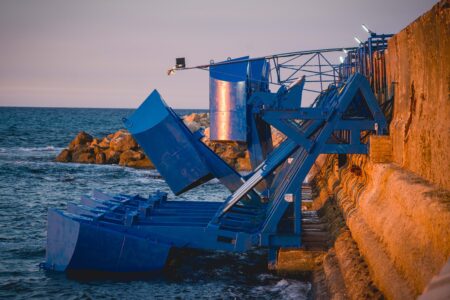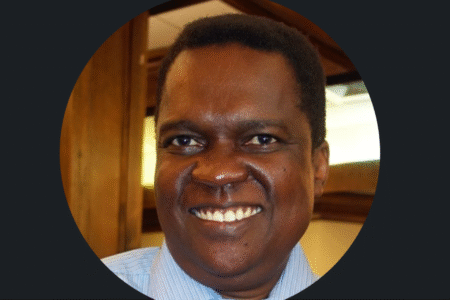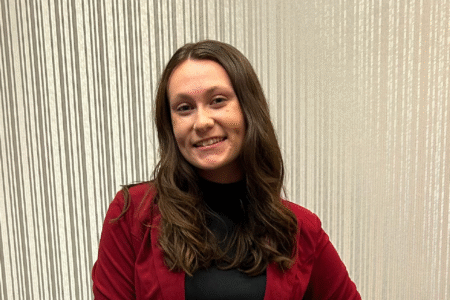Green Success Stories shines the Green Spotlight on Inna Braverman, CEO and Co-Founder of Eco Wave Power. We discussed her post-Chernobyl mission to make this world a better place, the role of wave energy as a largely untapped source of renewable energy, and the innovations of EWP that make wave energy cost effective, reliable, insurable, and particularly eco-friendly.

Tell us a bit about your sustainability journey.
For me, wave energy is a personal mission. As a baby, I barely survived the Chernobyl nuclear disaster – an event that ultimately led to my idea of sustainable energy production using wave energy.
Two weeks after I was born the Chernobyl nuclear reactor exploded, causing the largest in history nuclear disaster in terms of costs and casualties. I was one of the babies hurt by the negative effects of the explosion. Luckily, my mother, a nurse, approached my crib in time and saw I was blue, not breathing, and gave me mouth-to-mouth resuscitation, which saved my life.
When I was four, my family emigrated to a small town in northern Israel, Akko, where you don’t hear words like tech and startup, so I decided to study Political Science and English Literature at Haifa University, I thought that by going into politics, I could do something good for people with the second chance in life I received. However, when I finished my degree, there was no lineup of politicians waiting to hire a young lady with a degree in Political Science and English Literature, so I went to look for a job. I started as an English-Hebrew translator for a renewable energy company, which is where I learned about the whole incredible sector of renewable energy, including wind energy, solar energy, and wave energy; however, whereas the wind and solar energy sectors were already almost fully commercialized, in the wave energy sector there was a lot of room for innovation. So, at 24, I decided to focus on the development of an innovative solution for environmentally friendly energy generation from the power of the waves and founded Eco Wave Power.
According to the World Energy Council, wave energy has the potential to produce twice the amount of electricity than what is being produced now, but no one was making wave energy a reality. I knew I could make wave energy happen.
By using research databases, I started trying to understand why the tech used by other wave energy developers was too expensive and why it did not survive the marine environment, as well as what went wrong. I came up with my own concepts, but I didn’t have the money to build a power station or even register a patent.
One day, I went to a social event, and this guy, who had a hippie look, came and sat next to me, asking, “What is your passion?” His name is David Leb, and it turned out that he is a serial entrepreneur, who invested the proceeds of his business ventures into real estate, one property being a surf hotel in Panama, where he would watch the surfers and figured that there must be something else you can do with the energy of the ocean.
In a completely different side of the world, he also started researching wave energy and came up with his own concept and ideas on how to make wave energy a reality.
So, when we met and it turned out that both of us are passionate about wave energy, it was like a match made in business heaven. He ended up investing the first $1 million [USD], and that was the beginning of Eco Wave Power, which has grown significantly since and is now traded on Nasdaq Capital Market with the stock symbol WAVE.
Tell us a bit about the product or solution you offer.

Eco Wave Power has developed an innovative, patented, cost-efficient technology for the generation of clean electricity from ocean and sea waves. It aims to generate clean & affordable electricity, using a simple but smart design, where the floaters are attached to existing man-made structures, thereby simplifying installation and maintenance as well as accessibility.

Most wave energy developers have decided to install their equipment in the offshore zone (which is 4 to 5 KM into the sea). This created several significant problems:
- High Prices – Offshore installation is extremely expensive and complicated, as it requires ships, divers, underwater cabling, and underwater mooring.
- Low Reliability – Offshore, the wave energy power stations are exposed to wave heights of 20 m and higher. Man-made stationary equipment has no way of avoiding and surviving such forces, thus many of the offshore installations break down after a short time frame of operation (e.g., Pelamis, Oceanlinx)
- Difficult to obtain Insurance – Due to the high prices and low reliability of offshore wave energy technologies, insurance companies are usually reluctant to insure offshore wave energy solutions, which has also created difficulty in obtaining financing.
- Environmental Impact – Environmentalists, who were expected to be wave energy’s greatest advocates, are not always supportive of offshore wave energy technologies, as it is connected to the ocean floor and disturbs the marine environment.
Eco Wave Power has taken a completely different approach than most other wave energy developers and installs the equipment nearshore, which enables the technology to be:
- Cost-efficient – The price of the system is cost-efficient, as most of our system is located on land, just like a regular power station. This enables easy construction, operation, and maintenance.
- Reliable – Most EWP equipment is located on land and, therefore, it is not exposed to stormy marine conditions. In addition, EWP has a patented storm protection mechanism. When the waves are too high for the system to handle, the floaters automatically rise above the water level, and stay in the upward position until the storm passes. When the storm passes, the floaters are automatically lowered to the water and the system commences operation.
- Insurable – The EWP system is fully insurable by notable global insurance companies.
- Environmentally Friendly – The EWP system is 100% environmentally friendly as it does not connect to the ocean floor and does not create any new presence on the seabed. The EWP floaters only connect to man-made existing structures such as piers, jetties, and breakwaters.
Share a green success story with us – how have you helped customers or other businesses in the fight against climate change?
Eco Wave Power is making a significant difference when it comes to decreasing the global carbon footprint, and mitigating climate change.
We installed our first grid-connected wave energy array in Gibraltar in 2016 and operated it for 6 years until 2022, as part of a 5 MW Power Purchase Agreement that EWP signed with the Government of Gibraltar and Gibraltar’s National Electric Company, GibElectric. Initially, the array was intended to operate for only two years, to prove that wave energy can withstand storms. Due to its success, the company decided to keep the station operational for longer, and Eco Wave Power accumulated almost six years of operational experience.
In August 2023, we successfully deployed our second grid-connected wave energy array in the port of Jaffa, Israel. Eco Wave Power installed and is currently operating a 100-kW installed capacity station through a Joint Venture Agreement with EDF Renewables IL. EWP also received co-funding from the Israeli Ministry of Energy, which recognized the technology as a “pioneering technology.” This is the first wave energy project in the history of Israel to deliver electricity to the country’s power supply.
Moreover, Eco Wave Power is planning to deploy the following projects soon.
- Port of Los Angeles Project: Following an agreement between AltaSea and Eco Wave Power, we delivered an energy conversion unit to the AltaSea campus at the Port of Los Angeles. In October 2024 the company received the final Nationwide Permit (NWP) from the U.S. Army Corps of Engineers for its 100-kW pilot project, which will serve as a significant milestone bringing Eco Wave Power’s technology to the U.S. In addition, in January 2024 the company signed a strategic co-investment agreement with Shell MRE, for the implementation of the LA project. The company also conducted a comprehensive feasibility study with Shell, aimed at identifying the best locations for commercial onshore wave energy stations along the U.S. coastline and worldwide. Through the study we pointed out at least 77 sites in the U.S. that may be compatible with the implementation of Eco Wave Power’s technology.
- Taiwan: In October 2024, Eco Wave Power signed an agreement for the sale of the first wave energy generation unit with I-Ke International Ocean Energy Co., a subsidiary of Lian Tat Company, a leading maritime engineering company, with the purpose of bringing Eco Wave Power’s wave energy technology to Taiwan. According to the terms of the agreement, I-Ke will be providing full financing for the 100-kW pilot project, by buying a turnkey conversion unit from Eco Wave Power. The first stage of the project will be the development of a 20 MW wave energy power station in Taiwan, beginning with a 100KW pilot and expanding in stages to a total targeted installed commercial capacity of 400 MW.
- Portugal Project: In 2020, Eco Wave Power entered into a Concession Agreement with the Port of Leixões, or APDL (Administração dos Portos do Douro, Leixões e Viana do Castelo), to use an area for the construction, operation, and maintenance of a wave energy power station of up to 20 MW in four locations owned and operated by APDL. In March 2024, Eco Wave Power received the last approval necessary for the commencement of the works of the first megawatt in the city of Porto with the Título de Utilização de Recursos Hídricos, or TURH, from APDL. Eco Wave Power’s project will be a significant milestone in the adoption of wave and ocean energy in Portugal and will contribute greatly towards the country’s goal under the PNEC 2030 plan, of implementing 70MW of wave power capacity by 2030.
What would you do with $1 billion dollars?
With $1 billion dollars, our first priority would be to accelerate the global transition towards a cleaner, more sustainable future, specifically focusing on renewable wave energy technologies. 1 MW of wave energy can cost as low as 1.5 million USD when implemented at a commercial scale, which is defined as 20 MW and more. Based on this assumption, $1 billion dollars would allow us to develop approximately 667 MW of wave energy. With a capacity factor of 42%, this array will produce around 2.5 TWh of clean electricity annually. If the same amount of electricity was to be produced from fossil fuels, the emissions would equal 1,679,627 metric tons of carbon dioxide. This is equal to the carbon dioxide emissions from 188,998,164 gallons of gasoline consumed and is equivalent to the greenhouse gas emissions from 391,782 gasoline-powered passenger vehicles driven for one year, showing that the amount of greenhouse gas emissions avoided from implementing Eco Wave Power stations at a large-scale globally are a substantial achievement towards reaching global climate change goals.
Eco Wave Power currently holds a total projects pipeline of 404.7MW, including planned projects in Europe, the U.S., Asia and others, and the pipeline keeps growing. With $1 billion dollars, we would be able to grow our project pipeline by significant amounts. I think that upon the commercialization of wave energy around the world, we will start seeing significant impact in terms of mitigation of pollution from traditional nonrenewable energy sources, job creation and other positive impacts.
What do you envision your industry looking like in ten years?
In the next 10 years, I believe renewables will become a dominant global energy source, making a significant impact on the energy industry. My vision for Eco Wave Power is to see our pioneering, innovative technology installed on every marine structure around the world. More than half of the world’s population live within a 200 km (60 mile) range from an oceanic coast, meaning that the implementation and adoption of wave energy will have a significant impact on the world’s renewable energy mix. Marine structures are not prime real-estate, and serve a crucial purpose of breaking strong waves, and protecting ports and coastal communities. Harnessing wave energy from these existing structures would greatly benefit the entire field by generating clean electricity, creating local jobs, and providing economic benefit to coastal communities.
Further into the future, I envision that legislation will mandate, as early as in the planning phase of each new breakwater, that wave energy technology be incorporated into the design. Eco Wave Power’s pilot project in the Port of Los Angeles led to Senate Bill 605 (“SB 605”) being signed into the State of California. This is the first legislation of its kind that actively explores the costs and benefits of implementing wave energy technology. By implementing more legislation like this, it would save significant time and financial resources, and accelerate the commercialization and implementation of wave energy.
What would you like readers to take away from this article?
As CEO and Founder of Eco Wave Power, I hope that readers will come away with a clear understanding of our vision for harnessing wave energy and the crucial role Eco Wave Power plays in the global energy transition. Our innovative technology proves that wave energy is not only feasible but also sustainable, cost-effective, and environmentally friendly. By utilizing existing marine structures, we reduce costs and environmental impact while creating clean electricity, jobs, and community benefits. I want readers to recognize that wave energy represents a pivotal opportunity in the global energy transition. While solar and wind is already commercialized, wave energy remains a relatively new yet promising player in the renewable energy mix. Our work at EWP is about more than just creating energy—it’s about pioneering a path toward a cleaner, greener world.
Our projects, like those in Gibraltar and Jaffa, showcase the real-world potential of wave energy, and initiatives such as our Los Angeles project are driving policy changes to accelerate adoption. Ultimately, I want readers to see Eco Wave Power as a catalyst for change, an organization that is not just developing technology but fostering innovation and making meaningful contributions to a sustainable future. My hope is that this article inspires belief in the potential of wave energy and motivates support for its adoption worldwide.
How should readers get in touch with you and/or your organization?
Website: https://www.ecowavepower.com/
Facebook: https://www.facebook.com/ecowavepowerltd
LinkedIn Inna: Inna Braverman https://www.linkedin.com/in/inna-braverman/
LinkedIn EWP: Eco Wave Power https://www.linkedin.com/company/eco-wave-power/
Twitter Inna: @InnaBraverman https://twitter.com/InnaBraverman
Twitter EWP: @EcoWavePower https://twitter.com/EcoWavePower
Instagram: @ecowavepower https://www.instagram.com/ecowavepower/
YouTube EWP: https://www.youtube.com/user/EcoWavePower
Kudos
Many thanks to Inna Braverman and Eco Wave Power. Green Success Stories is happy to support and highlight your efforts! We invite you the reader to do the same.
About Green Success Stories
Green Success Stories is a media platform that highlights leaders in sustainability and climate tech.
We offer professional writing (articles, blogposts, case studies, and more) combined with social media promotion. You get great content + exponential publicity. As a starting offer, we’d like to feature you and your organization in a FREE PROFILE ARTICLE. There’s no obligation, but we’d appreciate you considering our services. Let us know if you’re interested and we’ll share more information.
Support Green Success Stories
Like what we’re doing? Please pitch in and help us highlight leaders in the fight against global warming.





